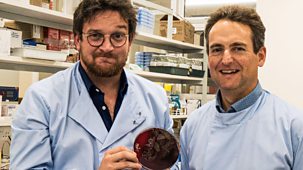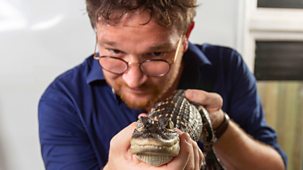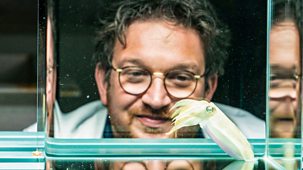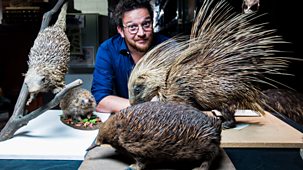
Series 1: 3. Protection
How does a giraffe stay cool? What are different porcupine quills teaching us about medicine? What makes some people more likely to be bitten by mosquitoes than others? All the answers and more lie in the secrets of how skin protects us from a hostile world. When it comes to protecting our delicate insides, skin is like an external suit of armour. Animals have adapted ways of protecting themselves from everything a hostile planet has to throw at them. \n\nHippos produce their own sunscreen to protect themselves against the dangers of UV rays from the sun. Only recently discovered by science, is the truth behind a giraffe’s spots, a network of blood vessels that they use to cool themselves down in the blazing heat of the African savannah. \n\nProfessor Ben Garrod discovers how. He tests the limitations of human skin by plunging himself into a deep freezer to demonstrate how human skin just isn’t well insulated enough to cope with extreme cold. He discovers how human skin is an entire ecosystem for bugs and bacteria as he comes face to face with what is growing on his skin. And he gets bitten by mosquitoes and stable flies as he learns that disease-carrying insects have evolved to pierce everything from human skin to horse hide.
Source: BBC 4
Most recent episodes of Secrets of Skin
Secrets Of Skin
Series 1: 6. Sensing
Professor Ben Garrod explores how some snakes can see using heat, how crocodiles feel through their jaws and how some animals use electricity to navigate their world - and it is ...
03-08-2023
BBC 4
Secrets Of Skin
Series 1: 5. Defence
What is the most toxic animal on earth? How are porcupine quills helping us in medicine? Why is a rhino armour plated, and it is not to protect them from lions? \n\nProfessor Be ...
02-08-2023
BBC 4
Secrets Of Skin
Series 1: 4. Communication
Why are male mandrill faces (big bold primates from West Africa) red and blue? How are birds' feathers so colourful? What do ringtail lemurs do to talk to one another? Their ski ...
01-08-2023
BBC 4
Secrets Of Skin
Series 1: 3. Protection
How does a giraffe stay cool? What are different porcupine quills teaching us about medicine? What makes some people more likely to be bitten by mosquitoes than others? All the ...
31-07-2023
BBC 4
Secrets Of Skin
Series 1: 2. Moving
What makes sharks built for speed? How do snakes move without limbs? How do sugar gliders fly without feathers? The answer all lies in their skin. \n\nProfessor Ben Garrod uncov ...
27-07-2023
BBC 4
Secrets Of Skin
Series 1: 1. Adaptability
Skin is an incredible, multi-function organ that science is still learning so much about. It has adapted to allow animals to conquer virtually every habitat on the planet. \n\nI ...
26-07-2023
BBC 4
Most popular episodes of Secrets of Skin
Secrets Of Skin
Series 1: 3. Protection
How does a giraffe stay cool? What are different porcupine quills teaching us about medicine? What makes some people more likely to be bitten by mosquitoes than others? All the ...
31-07-2023
BBC 4
Secrets Of Skin
Series 1: 4. Communication
Why are male mandrill faces (big bold primates from West Africa) red and blue? How are birds' feathers so colourful? What do ringtail lemurs do to talk to one another? Their ski ...
01-08-2023
BBC 4
Secrets Of Skin
Series 1: 1. Adaptability
Skin is an incredible, multi-function organ that science is still learning so much about. It has adapted to allow animals to conquer virtually every habitat on the planet. \n\nI ...
26-07-2023
BBC 4
Secrets Of Skin
Series 1: 2. Moving
What makes sharks built for speed? How do snakes move without limbs? How do sugar gliders fly without feathers? The answer all lies in their skin. \n\nProfessor Ben Garrod uncov ...
27-07-2023
BBC 4
Secrets Of Skin
Series 1: 5. Defence
What is the most toxic animal on earth? How are porcupine quills helping us in medicine? Why is a rhino armour plated, and it is not to protect them from lions? \n\nProfessor Be ...
02-08-2023
BBC 4
Secrets Of Skin
Series 1: 6. Sensing
Professor Ben Garrod explores how some snakes can see using heat, how crocodiles feel through their jaws and how some animals use electricity to navigate their world - and it is ...
03-08-2023
BBC 4






